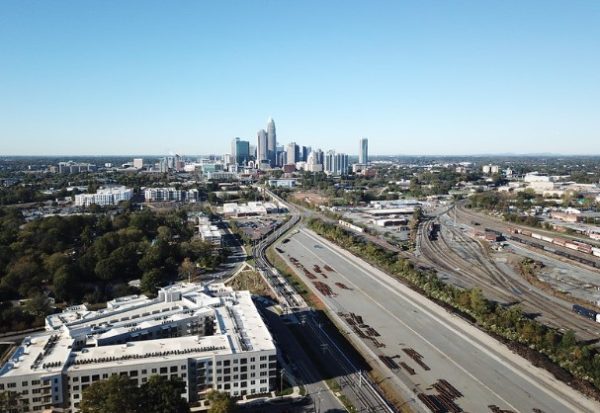Transit talks feel like ‘Groundhog Day’

In honor of (last week’s) Groundhog Day, and to mark the city’s transit discussion that keeps circling back to the same core points, we’ve compiled a list of the recurring questions that just keep poking their head out of the hole.
- To briefly recap: Charlotte wants to spend $13.5 billion to expand its transportation system, with 80% of that going to transit projects (largely a new east-west Silver Line) and the rest going to things like bike lanes, sidewalks, greenways and road improvements. The Republican-controlled General Assembly isn’t on board — House Speaker Rep. Tim Moore blasted the proposal for spending too much on transit and not enough on roads — which is a problem, because the city needs the legislature’s permission to put a one-cent local sales tax on the ballot in Mecklenburg County. No sales tax referendum = no money = no transit.
Here are the four things we heard this week that most strongly made us feel like we’re trapped in the movie “Groundhog Day”:
1. Should Charlotte push for a transit tax?
It’s arguably the most fundamental question here — is Charlotte going to push for a new transit tax referendum in Raleigh, and when?
In 2020, Charlotte Mayor Vi Lyles said, “What I would like to see is a potential referendum in 2021. I don’t think we can afford to wait.”
In 2021 and 2022, local leaders again said they thought the city needs a transit referendum ASAP.
Now it’s 2023, and there’s no indication Charlotte has made a formal request at Raleigh for a tax referendum, and there still seems to be disagreement over the strategy to approach the General Assembly.
At the City Council retreat on Monday, staff gave a presentation to make the case for a sales tax as the best way to finance the plan. A sales tax, they said, would cost residents an average of $177 a year, while a property tax would cost $694 a year per household to raise the same amount of revenue.
Council member Malcolm Graham said he thought the city had already decided to pursue a sales tax increase as the only viable plan.
“One I thought we’ve already answered was that we’re going after the sales tax. I didn’t know there was a debate of there being any other option. I thought that was a foregone conclusion,” Graham said.
Adding to the confusion: Dana Fenton, the city’s lobbyist, told council on Tuesday that the city’s plan as-is would be “dead on arrival” in Raleigh, because it would be seen as too Charlotte-centric to gain support.
“Until we either get the nod, or pat the brakes, pump the brakes,” said City Manager Marcus Jones, “we’re just trying to get to the place that this is an option.”
2. Will the plan be regional or Charlotte-focused?
The city is leaning toward building a regional transit strategy as a way to garner support in the legislature, getting regional buy-in from Republican-led counties around Mecklenburg in order to win approval for a referendum.
A regional vision for transit, the more bus-centric “Connect Beyond” plan, is in the works at the Centralina Regional Council. But it’s unclear that counties around Charlotte would be interested in a plan that’s mostly Charlotte-based, especially for any big-ticket spending like new rail lines.
One way around that might be a regional authority to run Charlotte’s transportation system, rather than having it be a city of Charlotte department. City staff showed a comparison of peer cities, all of which have some kind of authority to run their systems.
“Is our current structure, having transit as part of the department, hindering us?” Council member James “Smuggie” Mitchell asked.
The answer: Maybe. But that will take more study, and, of course, many rounds of discussion with our surrounding counties to untangle.
3. How to rebuild uptown’s bus station, and where to put the Silver Line?
City Council wasn’t the only government body meeting about transit this week. The Metropolitan Transit Commission, which sets policy for the Charlotte Area Transit System, also held a meeting Tuesday to discuss the plans for two of the city’s biggest transit projects, the Silver Line and the Charlotte Transportation Center.
Despite months of questions about routing the train around, rather than through, uptown, and about whether burying the bus station underground to build a tower atop it is the best idea, both of those ideas are moving forward.
That’s despite Sustain Charlotte — a major transit advocacy group — voicing concerns about the plans late Tuesday. The group said it’s “deeply concerned about safety, equity and cost of moving the bus station underground” and wants to see a Silver Line route that “prioritizes ridership over development.”
City and regional leaders, though, have repeatedly sided with city staff and have decided against alternatives.
4. What matters more — frequency or ridership?
As CATS struggled to run buses on time last year because of a bus driver shortage, the transit agency cut service. And as it cut service, ridership fell more.
It’s a spiraling problem that a lot of transit agencies across the country are dealing with: Should you try to get riders back by bringing back service, or wait for demand and then add trips?
And like other cities, Charlotte doesn’t seem to have a good answer. “I think it’s a question of what comes first, chicken or the egg, right? We often say well, ridership will be addressed if we address the frequency issue. Well, there’s another component to it, we can’t invest unless we see an increase in ridership,” said Council member Dimple Ajmera.
“It is a bit of a chicken and egg there,” said CATS senior planner Jason Lawrence.
“Frequency does drive ridership and ridership sometimes drives the frequency.”
This story was originally published as part of the Transit Time newsletter, jointly produced by WFAE and the Charlotte Ledger.
Ely Portillo, WFAE and Tony Mecia, Charlotte Ledger